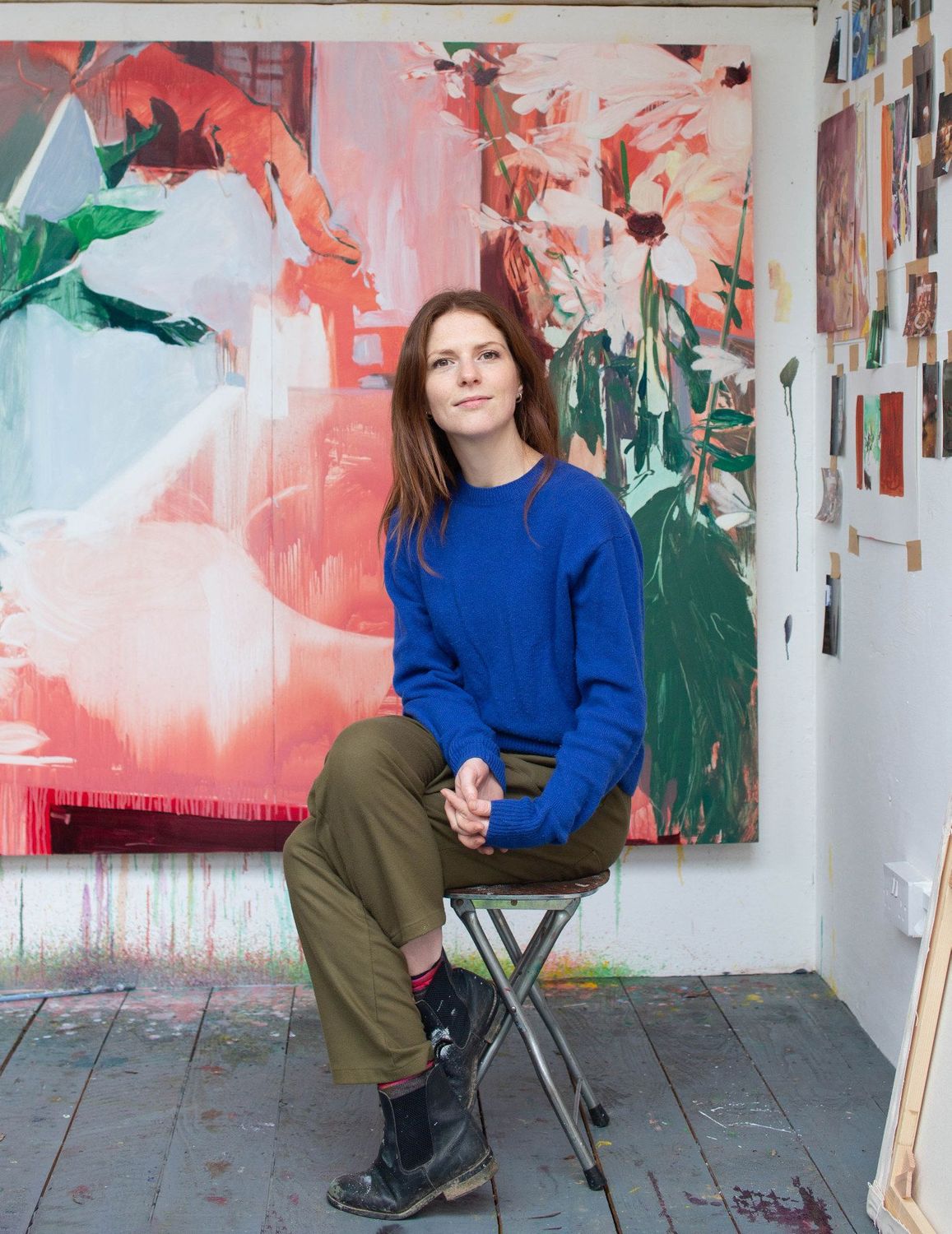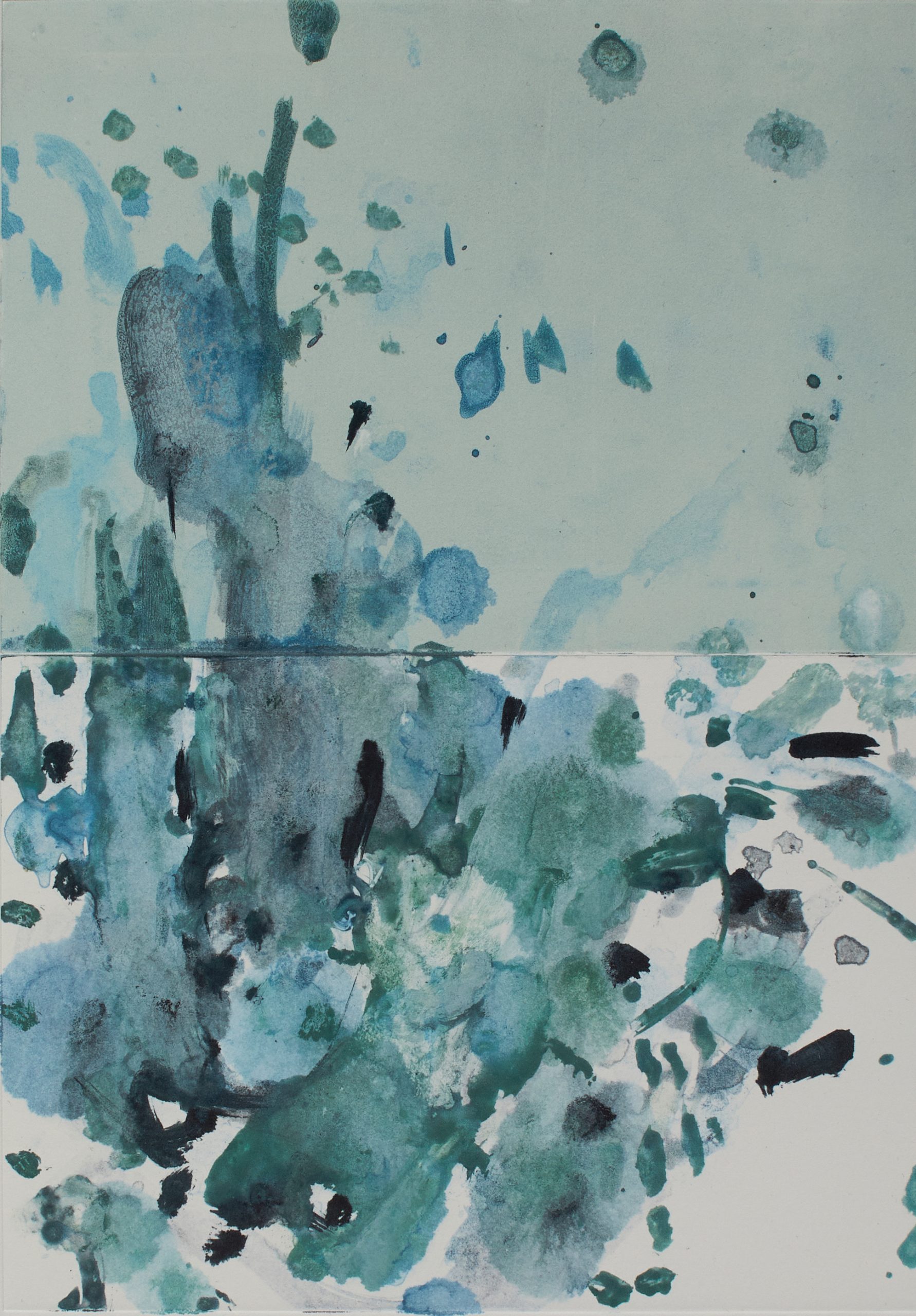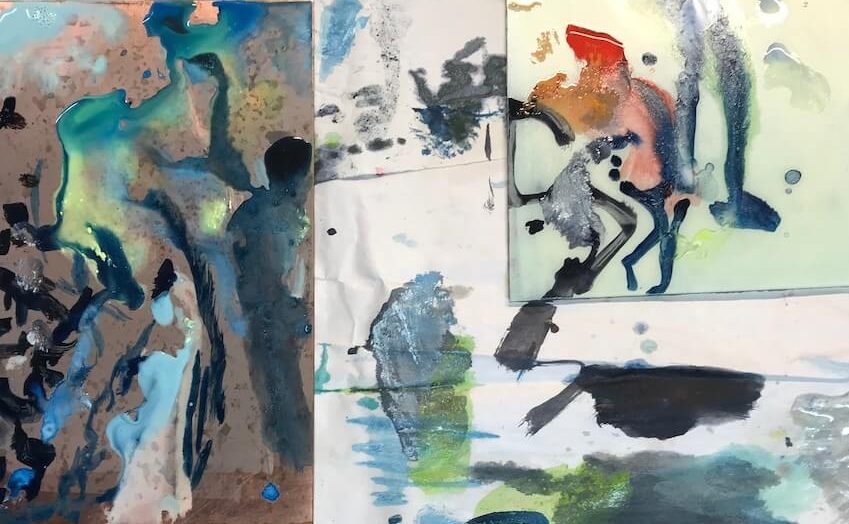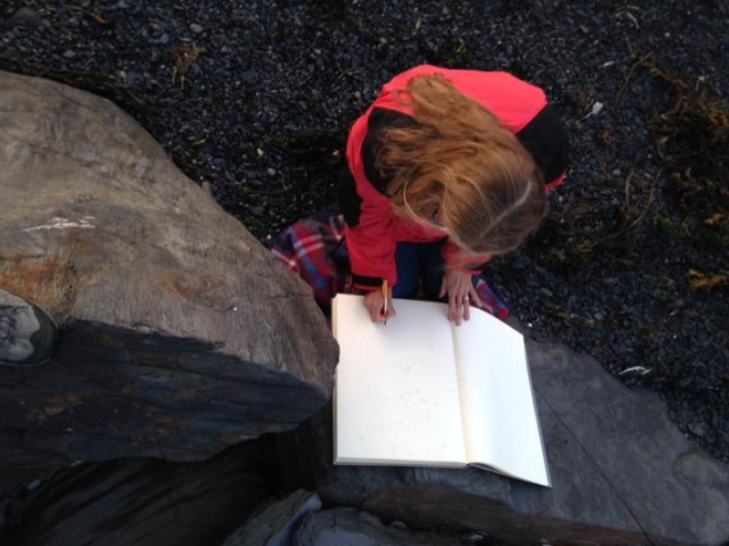 © Michael Dillon
© Michael Dillon
FEATURE
Daydreaming through decoration
“I felt like I was in multiple spaces at the same time – the studio, my source material, my paintings – and I really lost myself in the process of making. I had this epiphany that if I inhabited my paintings long enough then the experience of looking at them would contain the dysphoria I felt, because that’s how art works, it’s a sort of a mirror.”
We talk to Eleanor Watson, painter and printmaker, about how themes develop, deepen and shift during an artist’s practice.
HAUSPRINT: Though your work often circles around themes of home and domestic spaces, we rarely see any people. Can you talk about this?
Eleanor Watson: When I was studying for my degree (BA Fine Art Painting; Wimbledon College of Arts), I started making paintings from film and TV stills. I found that I was much more interested in the sets rather than the action or the figures. I made a painting in my third year, which was from a magazine image, and it really resonated as lots of things that I am interested in came together at this time. It was something about interiors but also that aspirational magazine life, showing off your home, being very house proud. Within that I was thinking about the complicated connotations about the domestic space, not least the commentary on class, but also Gaston Bachelard’s oneiric view of domestic spaces being the potential for a kind of nostalgic daydream, and Johannes Vermeer paintings that I loved, and a Peter Doig exhibition that I had seen a few years ago and showed how he worked with photographs.
HP: Is it something about understanding that the image holds more than we can see?
Eleanor: At school my teacher Mrs Benton seeded in us an understanding of negative space and this became the lynchpin of the way I worked from photographs – thinking about abstract space, flattened areas of colour that came together to describe figurative space. Then at Wimbledon I had a brilliant tutor who is a superb painter, Nelson Diplexcito, and one of the things he instilled in his students was an idea about ‘the economy of means’ and how little you have to do to describe something, to communicate an idea. At the time I took that to be about a reduction of information when it came to making figurative work and describing space, using a very flattened, photographic language.
I’d also fallen in love with going to the theatre, and it was incredibly cheap to go as a student so I went all the time. I was really interested in the stage sets and the weight given to objects on stage and again there’s that reduction of information, of how little you need in a space to evoke another world. I always loved that moment when everyone hushed and the stage was lit before the actors came on. It’s also super artificial so it related back to the magazine worlds that I would daydream about or project myself into.
HP: How did seeing the huge scale of stage sets impact on your practice?
Eleanor: My first solo exhibition was at the Foundry Gallery which was a gallery housed in an architects’ practice. Because of this the gallery showed artists exploring the relationship between art and architectural space from different perspectives. It was 2013 and it was my first opportunity to make an all encompassing exhibition of my own. I thought back to my love of the theatre and theatricality for inspiration and alongside smaller works made a vast painting for me at the time which had that feeling of proscenium arches.




HP: How did making work for that exhibition impact on what you were painting?
Eleanor: I began to think a lot more about the decorative quality of painting. At the time I was looking at the paintings on panel of Eugène Brouillard (1870-1950) and really delighting in speckled marks and colour and feeling much more abstracted in some sense. There was also symbolism and that very British preoccupation of home and garden-making.
I continued to make paintings in a similar theme of historical interiors, looking at fabrics and pattern and decoration and how I could play with those. How things were lit so objects kind of dissolved in the light and created these intricate patterns that came up against another pattern. These interiors lent themselves to a particular kind of painting and I really enjoyed that for a time, until the paintings tipped over into feeling constrained and tight. I was very aware that the images brought up a lot of themes that I didn’t have the language or the ability to articulate, either in paint or in words. I really struggled to push forward at a time when I felt a commercial pressure to make more paintings to sell, so I found it hard to take risks or work out where to go with what I was doing.
HP: How did you find your way?
Eleanor: I knew in my gut that I wasn’t quite ready for a Masters and that rigorous academic approach but I wanted to push myself and do something different so I went to the Royal Drawing School for a year of observational drawing. It’s a scholarship programme and you pick your syllabus out of the public programme of drawing classes. It’s brilliant because you’re learning a whole load of different approaches to drawing – each term I’d have up to nine tutors, all working artists with individual approaches to visual language. Of course that’s the lynchpin of figurative painting, or visual art perhaps, but at Wimbledon there was very little teaching or focus on drawing so it was something that I hadn’t really spent time doing since being at school.
HP: What was the most valuable thing you learned?
Eleanor: I learned a ton but there was so little time to actually make my own work whilst learning and trying to make a living, and London life, so when I came to the end of the year I felt quite uncertain. I knew that I really needed to go and process what I’d learned, so I applied both for a Masters – which I was unsure whether I was ready to do – and also for a residency. Fortunately I got the residency and I didn’t get the Masters. I went up to Derbyshire for a year for the residency, the Jonathan Vickers Fine Art Award, which is a really generous award with a stipend and a studio. I did some teaching at the University of Derby and had a solo exhibition in the Derby Museum & Art Gallery, with a catalogue and an essay written by Sara Terzi, which was just the best experience for my mid-twenties, to have the time to make that body of work. There was mixed success in the work itself but the experience of making an exhibition and building it, even putting up walls and thinking about audience expectation of space and how people would encounter the work, fed back into my interest in the theatre of exhibiting.
HP: What drew you to this residency?
Eleanor: It had a theme (‘the changing faces of Derbyshire’) and I thought that might solve some of the content crisis questions I was going through, like ‘why am I making these things when I don’t have the language to talk about them?’ I was quite self conscious about the themes of heritage and empire, heavy themes that I didn’t quite know how to go into. I thought that if I had a more specific narrative set by a themed residency that might help me more, so in the Dexter Dalwood vein of individual paintings having a particular thought or narrative behind it, I made a series of paintings referencing the lives of important women in the area. I met an amazing poet, Sandeep Parmar, an activist and a boxer, among others.
HP: This is when you exhibited your first monotype too?
Eleanor: I was playing with layering different references, so less photographic, using wallpaper to lift paint off, almost like a monotype within the painting, using that idea of negative space and pattern making but playing with the patterns dissolving and reappearing in the image. I’d been making monotypes for a few years and another artist friend Rosey Prince showed me how to make monotypes without a press. They really appealed to me because they were somewhere between drawing and painting. The wiping away technique lent itself to that negative space type of drawing and the trace monotype offered lots of potential for making ghosts and making incidental tone and mark, introducing chance and magic into the making. It felt right to exhibit a monotype alongside my paintings.
HP: You came back to London and decided you wanted to do a Masters at City & Guilds. What were you thinking about as you were applying?
Eleanor: I was really motivated to challenge myself and what I was doing with my work as I was making the application. I made new work for my portfolio including ‘Mustard Mirror’. I wanted to challenge the viewer’s perception of space and complicate their relationship with the space that’s depicted. I remember reading a really interesting essay by Michel Foucault on heterotopias and the idea of a mirror being a virtual space but you project yourself into it so it’s both real and unreal at the same time. (‘Des Espace Autres,’ was the basis of a lecture given by Foucault in March 1967 and has been translated into English under the title ‘Of Other Spaces: Utopias and Heterotopias’). I was using my recurring motifs but trying to push further all the time: negative space; things dissolving and reappearing; mirrors and objects depicted by light and flattened; patterns; pictures within pictures.


HP: What did it feel like to take part in a Masters?
Eleanor: I turned up and I felt terrified to paint. I didn’t want to fall into the traps I had in the past. Instead I began making monotypes more seriously, as a bridge between drawing and painting. I was tiling them up so they got bigger and bigger to make them feel more like a kind of enveloping space, creating more of an experience of looking and exploring something with overlapping spaces and marks. There was something about the texture of the monotype that really resonated with some of the imagery I was making.


I felt that my content crisis had to come to a head and like I had to interrogate my imagery, really take it on and try to find the language to describe the things I was making. So I really went for it with images of big stately homes, massive wealthy interiors full of texture and objects and antiques. I began to write my thesis and tuned into that feeling of my earlier paintings, daydreaming myself into a space but also feeling quite uncertain about my relationship to it.
HP: This sounds like a very intense time in your practice. Can you say more about your thought process?
Eleanor: I was thinking about all these layered experiences of domesticity and class and representation – the class connotations of that magazine lifestyle imagery; the performative relationship to a house and a home; being house proud; a house being quite a complicated space as both a sanctuary from the outside world but also a place of complicated relationships; how you can feel vulnerable on show or be yourself whilst hiding away. The monotypes got bigger as I tiled them up. Working from photographs this speckled texture of the monotype felt almost entropic, almost like an analogue film or photographic process that was entwined with nostalgia, so I leant into it and embraced it. I had really difficult conversations that made me feel incredibly uncomfortable and put me on the spot about white privilege and what that meant. This was before the Black Lives Matter campaign was as visible as it is now so I really threw myself into quite dense texts. I had an incredible tutor, Jon Shaw, who helped me find my way through this incredibly nerve-wrecking content.


HP: How did reading around these subjects change your work?
Eleanor: The work became more like immersive theatrical installations. I was interested in layering experiences and complicating the spatial relationship between the viewer, the object and the space depicted, so I started layering actual objects and collage in the spaces to make installations. I made the monotypes on newsprint or japanese paper, with oil on canvas paintings and little etchings of Dutch still lives as objects on top.
For my degree show piece I wanted to make this enveloping space that you stepped into and became immersed in this green wash of colour, so either side there were crop sections of shipwrecks that faced one another. I was trying to make the experience of looking quite vertiginous, so your relationship to it was a little bit uncertain and unsettling in some ways. In contrast to the movement of the sides, in the middle was an incredibly still image of an ornate historic interior that felt like no one was breathing in there.
Over the top I hung these little paintings that acted like objects or antiques or collectables. I’ve always been interested in the value we give things and the little paintings played into the idea of the ‘valuable Art object’, Art with a capital A, that sits alongside your antiques.




HP: You’ve mentioned Dutch still lives and interiors before. What draws you to them?
Eleanor: I’m fascinated by Dutch still lives for their mastery and almost the arrogance it takes – it’s like the pinnacle of painting, that feeling of mastering death and making these exquisite perfectly depicted spaces. I’ve made paintings, prints and drawings, including hybrid works of monotypes pasted onto canvas with washes of colour over the top, from female Dutch still lives by artists Clara Peeters and Rachel Ruysch.
HP: How did the pandemic impact on your practice?
Eleanor: When the world collapsed in 2020 one of the positives was that everything slowed down. All exhibitions were cancelled, and I wasn’t able to make large pieces of work because of the travel restrictions on going to the studio, so I started making these small watercolours. I also felt I wasn’t really able to commit to anything larger and this was all I was capable of, partly because of the pandemic but also because of a recent bereavement which meant I just found it really difficult to be in the studio and feel content painting. Working on small watercolours became a lovely little escape. I’d become so aware of always having to justify what I was making and why so I gave myself permission to make what I wanted – not to feel self conscious and not to have that ongoing content crisis. This was the beginning of allowing myself to inhabit the painting and allowing the painting to be in and of itself the thing without too much explanation for it.


HP: What was different about working at a small scale?
Eleanor: The importance of the colour and the mark and the materiality of watercolour became much more important. I just really enjoyed making them. The upside of having that upheaval in the world was that I realised that in ‘the’ world and in ‘my’ world whatever I did wasn’t going to make or break anything so I could just enjoy making what I wanted, quietly and on a small scale.
HP: It seems that you naturally began to scale up again without any outside pressure, but was it a conscious decision?
Eleanor: I was thinking about moments of description in the paintings and moments of just colour and wash, and the surface going in and out of focus. I saw that to get to where I wanted I needed to allow the paint more agency than I had before, otherwise the paintings would get more uptight again. I kept thinking back to that expression of Nelson Diplexcito’s about ‘the economy of means’. For me at this point it was that I wanted the paint to do its thing, I wanted the paint to speak. Scaling up meant much larger pockets of abstract colour meeting each other and overlapping.


HP: How did your source material change during the pandemic?
Eleanor: When I was looking for source material online I was using really really naff search terms like ‘morning light aesthetic’, following rabbit holes into these kind of kitsch images that were just soothing to me in some way and somehow acted like daydreams.
HP: It must have felt quite unreal, looking at your source material from around the world when no one could go anywhere physically?
Eleanor: I was thinking about different levels of escapism. Everything was shut down and we were all in our homes so even going to the studio felt like such an amazing escape. When I was there I was also projecting myself into my source material, these other spaces. Then there was the space of the paintings, how colour and form interacted and how I reacted to those. I had a feeling of dysphoria, of just being in multiple spaces at the same time and really losing myself in the process of making. On a selfish level that was really what I was getting out of making the paintings – I had this epiphany that if I inhabited them long enough then the experience of looking at them would mimic my dysphoria, because that’s how art works, it’s a sort of a mirror.
HP: Going back to giving the paint agency to just be itself, how did you apply this principle when making prints?
Eleanor: I started making watercolour monotypes, which felt like a really magical confluence of my experience of making monotypes and paintings and watercolours. All of it just came together. Monoprinting has this moment in the making – the reveal – that felt like its own thing. There’s a feeling of peeling something back and almost glimpsing your subconscious – you’ve made something but then you’re surprised at what it looks like when it reveals itself to you – which is really beautiful.
The quality of watercolour monotype is very special because it almost hovers on top of the surface. You put a painted plate through a press with damp paper and the water lifts off the paint, it reignites dry pigment and lifts it onto the paper. It feels like it’s just floating there and there’s a special luminosity to the paper with the white of the paper coming through. They’re really lovely to make.






Eleanor: I began by going to my ten year old self and tried to make pictures of things or tried to describe things really well to get a representational kick, but increasingly I realised the watercolour monotypes were much more about the experience of beholding things or seeing things or remembering things. Or the experience of just putting pigment down – it could simply be that, but I had much more of an abstracted sense too. Going back to my interest in decoration and the decorative being enough in and of itself, I felt the joy of beautiful things as a form of expression in themselves, becoming more abstracted but also full of desire. Having said that, I was also making this series for an exhibition at the Wilder Gallery, which was fundraising for a brain tumour charity, so the works feel quite entwined, sadly, with that too. That series feels really precious to me on many levels.
HP: What does making prints bring to your painting practice?
Eleanor: I wanted to bring some of that joy of surface and decoration and abstraction back into the painting studio so I began to make these much more abstracted sketches and studies of things from similar source material. The monotype process fed back into my oil painting practice, where things are beginning to dissolve and fragment and become more abstracted. I feel like it’s to do with a kind of decoration and chintz but also lots of other things and that feels daunting. For me it’s totally terrifying because the paintings feel much more revealing and I feel really vulnerable around and towards them, but I’m hoping that renewed openness is interesting to look.
HP: How does this relate back to ‘the economy of means’ you talked about earlier?
Eleanor: I have been thinking a lot about that ‘economy of means’. I think my earlier reductive method of making work from photographs was a defensive mechanism related to justifying my practice, so it was about not being gestural and avoiding a lot of things that now I am trying to face. Using gesture means being a bit scared of my own work and being surprised by what the paintings look like. I think that’s really been brought on by that year of just making watercolours and watercolour monotypes and a renewed interest in different effects in oil painting.
HP: Would you tell us about how you title works?
Eleanor: I tend to go back over texts that spring to mind that I’ve read or that I have made notes from and underline a whole ton of words, phrases, sentences to use as titles. I’m not a natural wordsmith so I borrow beautifully written words by much cleverer people. As an example, the series of watercolour monotypes I made for the Wilder Gallery in 2021 is called ‘Between six and seven’, and it’s taken from a passage from Mrs Dalloway:
“And it was the moment between six and seven when every flower – roses, carnations, irises, lilac – glows; white, violet, red, deep orange; every flower seems to burn by itself, softly purely in the misty beds; and how she loved the grey-white moths spinning in and out, over the cherry pie, over the evening primroses!”
Virginia Woolf, Mrs Dalloway
The works for the exhibition were made between winter and the beginning of spring – that moment in the year where you get a bit longer and you have that magical hour or so of extra half light and all of the spring flowers glow in that slightly elongated day. The works really resonate with this passage and the grey-white moths felt really reminiscent of the surface of a watercolour monotype, how it just hovers almost like the dust on a moth’s wing.
Find more of Eleanor’s work at https://www.eleanormaywatson.co.uk/
You may be interested in
Monotype with water washable inks | 3 Saturdays | October 2024
Explore monotype printing over three mornings at HAUSPRINT. This course is designed to give you a really good understanding of using water washable printing inks to make painterly monotypes.
Etching: Soft Ground | 3 Tuesday evenings | Oct & Nov 2024
For those wanting to explore etching but feel the pressure of drawing, our three evening course investigates texture, pattern and mark-making through soft ground.
More Features
All featuresCollecting the Looking
“I love drawing really quickly. I love drawing in really difficult situations. I love drawing in the dark. I like what happens when you can’t see everything or when it’s passed and you have to remember it rather than drawing what it actually looks like, so it’s about the experience of looking as much as what I’m looking at.”
We talk to Michelle Avison about building a resilient artistic practice over 30 years.






